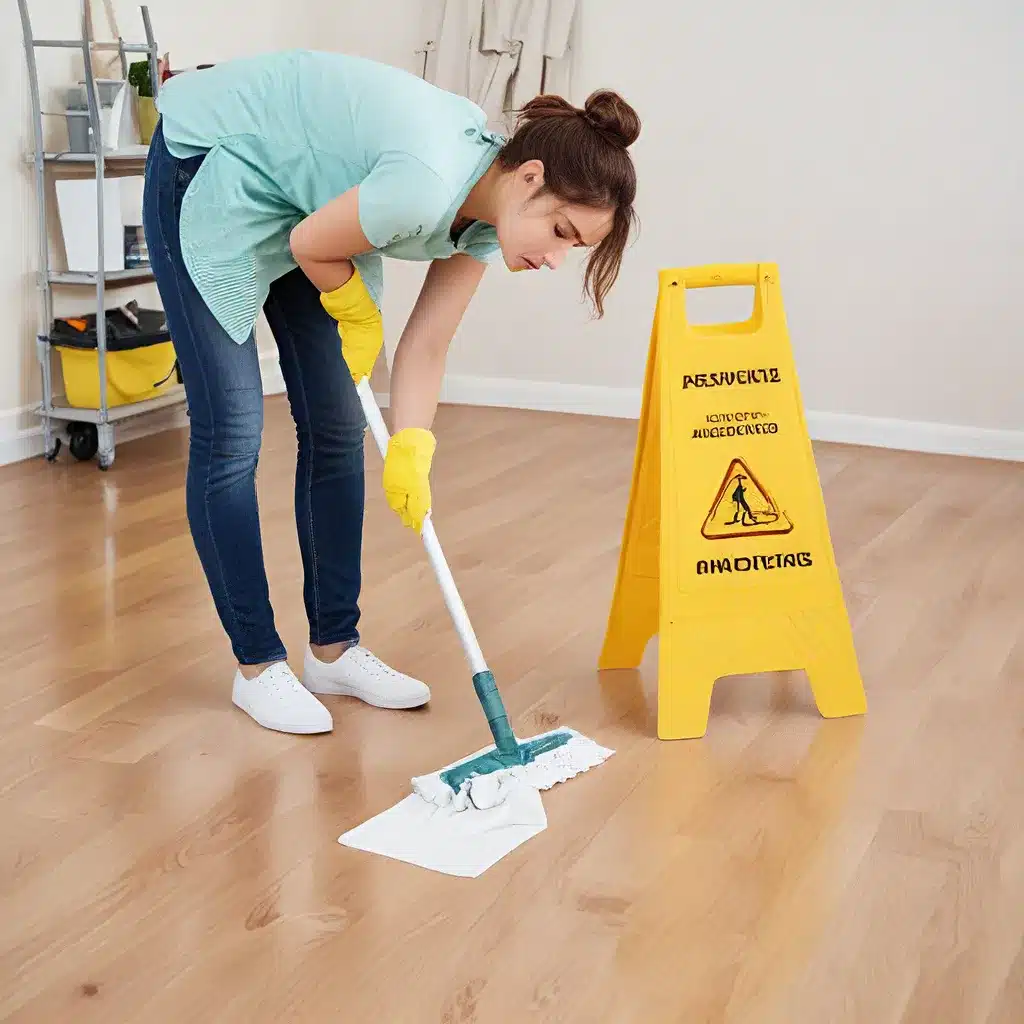Slip and Fall Hazards: Navigating the Slippery Slope
As I step into the kitchen, the linoleum floor gleams with a fresh shine. But just as I’m about to grab the mop, I catch a glimpse of a small puddle near the sink – a recipe for disaster waiting to happen. Slip and fall accidents are some of the most common hazards faced by cleaning professionals and homeowners alike.
The statistics are sobering: In the United States, slip and fall incidents account for over 1 million emergency room visits each year, with 15% of all accidental deaths occurring due to falls. These accidents can range from minor scrapes and bruises to debilitating injuries like broken bones, traumatic brain injuries, and spinal cord damage.
According to the National Law Review, the most common causes of slip and fall accidents in the home include wet or slippery floors, uneven surfaces, poor lighting, and cluttered walkways. As a conscientious cleaner, it’s crucial to be vigilant about these potential hazards and take proactive steps to mitigate the risks.
One of the best ways to prevent slip and fall accidents is to establish a thorough cleaning routine. This means regularly mopping and drying floors, keeping walkways clear of obstacles, and ensuring adequate lighting throughout the home. It’s also important to exercise caution when cleaning near wet or slippery surfaces, using appropriate safety equipment like non-slip shoes and mats.
Avoiding Chemical Exposure: Protecting Your Health
Cleaning products are essential tools in our arsenal, but they can also pose serious health risks if not handled properly. Many common household cleaners contain toxic chemicals like bleach, ammonia, and volatile organic compounds (VOCs) that can irritate the skin, eyes, and respiratory system.
According to Indeed, prolonged exposure to these chemicals can lead to a range of adverse health effects, including headaches, dizziness, and respiratory issues. In extreme cases, it can even contribute to the development of chronic conditions like asthma and cancer.
As a responsible cleaner, it’s crucial to read product labels carefully and follow the manufacturer’s instructions for safe usage. This includes wearing appropriate personal protective equipment (PPE) like gloves, goggles, and respirators when handling hazardous substances. It’s also a good idea to work in well-ventilated areas and avoid mixing different cleaning agents, as this can create toxic fumes.
Ergonomic Risks: Preventing Musculoskeletal Injuries
Cleaning may seem like a straightforward task, but it can actually be quite physically demanding. The repetitive motions, heavy lifting, and awkward postures involved in cleaning can put a significant strain on our musculoskeletal system, leading to a range of injuries like back pain, muscle strains, and joint inflammation.
According to the Patterson Legal Group, some of the most common ergonomic risks associated with cleaning include poor posture, excessive bending and reaching, and the use of heavy or unwieldy cleaning equipment. These factors can contribute to the development of chronic conditions like carpal tunnel syndrome, tendinitis, and bursitis.
To mitigate these risks, it’s essential to prioritize proper ergonomics in your cleaning routine. This includes using adjustable or lightweight cleaning tools, taking frequent breaks, and practicing good body mechanics when lifting, reaching, or bending. It’s also a good idea to rotate tasks and diversify your movements to avoid repetitive strain on any one muscle group.
Staying Vigilant and Informed: Cultivating a Culture of Safety
As a cleaning professional or a conscientious homeowner, it’s crucial to maintain a proactive approach to safety and continuously educate yourself on the latest best practices. This might involve attending safety training workshops, reading industry publications, or staying up-to-date on the latest research and regulations surrounding cleaning and workplace hazards.
By fostering a culture of safety within your organization or household, you can empower your team or family members to identify and mitigate potential risks, and respond effectively in the event of an accident or emergency. This might include implementing comprehensive safety protocols, regular safety audits, and comprehensive incident reporting procedures.
Remember, the health and well-being of you and your loved ones should always come first. By staying vigilant, informed, and proactive, you can help create a safer, more secure environment for everyone involved in the cleaning process. And who knows, you might even discover a few clever hacks or ingenious solutions that make the job a little easier and a lot more enjoyable along the way.
Adam Cleaning is here to help you navigate the complexities of safe and effective cleaning, offering a wide range of residential and commercial services tailored to your unique needs. Contact us today to learn more about how we can transform your space while prioritizing your health and safety.







